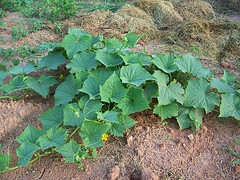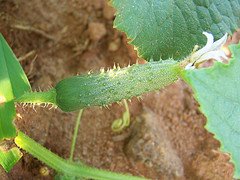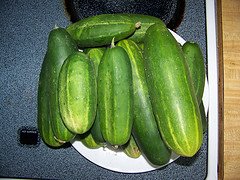Diagnosing and Curing Cucumber Diseases and Pest Problems

Most cucumber diseases are caused by pest problems in your cucumber patch. Many hybrid cucumber varieties today have been engineered to be disease resistant, but not disease proof. And they certainly aren't resistant to pests.
In general, if you keep your cucumber patch clean and free of weeds and plant debris, you'll already have a head start on pests and diseases. In most cases, weeds are only a problem before the plants spread out and get fully established. Once the plants start vining out, the leaf canopy they produce will usually stunt most of the weeds.
Pests That Cause Cucumber Diseases

Cucumber plants are susceptible to three main pests:
Cucumber Beetles will generally wreak the most havoc in your cucumber patch. They love to suck on the young seedlings and will carry wilt disease from plant to plant. They also chew holes in leaves and flowers. Cucumber beetles are usually identified by their black and yellow stripes. They are easily controlled throughout the growing season. When seedlings first emerge, a cone made of mesh wire or cheesecloth can be placed over the plants. Additionally, pesticides can be applied to keep the bugs at bay. Make sure that the product you choose will eliminate cucumber beetles. When the blossoms appear, stop spraying for bugs temporarily so that the bees will be able to pollinate the plants. If you start early in the season and can manage to keep away the beetles, you'll greatly lessen the chances of the development of cucumber diseases.

Slugs may appear when the fruit is just beginning to form. Slugs love to suck on young cucumbers. Most garden centers sell special slug pellets that can be spread around your cucumber plants. If you are interested in growing organic cucumbers, you can put down a layer of sand under and around the developing fruit. As slugs do not like to crawl across sand, they won't be able to reach the young fruit and no damage will be done.
Aphids have been known to colonize on cucumber plant leaves and buds. They can be controlled the same as cucumber beetles with a small mesh cone for emerging seedlings and an occasional dose of appropriate pesticide before the blossoms appear.
To address pest problems in our own garden, we've implemented a preventative spray program using a homemade soap spray. We mix together 2 gallons water, 4 tablespoons liquid dish soap and 4 tablespoons hot sauce in a pressure sprayer. We spray this mixture all over our cucumber plants every 10 days or so or after every heavy rainfall. This mixture doesn't actually kill any pests, but it does encourage them to move elsewhere.
Depending on the cucumber variety you plant, you may rarely have problems with other cucumber diseases. Most of them are fungal infections. You can avoid these problems by choosing diseases-resistant cucumber varieties. One of the more common diseases is powdery mildew. This is identified by white, mildew-like patches on the leaves. It can be controlled fairly easily. At the first sign of mildew, apply an all-purpose fungicide to the plants. These spray products are available at most garden centers. A good fungicide will also eliminate downey mildew. Downey mildew is identified by yellow, mildew-like patches on the leaves. If you are trying to grow cucumbers organically, most garden centers carry soap sprays and other organic ways to combat fungal and bacterial problems.
We've implemented a preventative spraying program in our own garden to prevent fungal infections and we've had good results. We mix together 2 gallons water, 4 tablespoons baking soda and 4 tablespoons hydrogen peroxide in a pressure sprayer. We spray this mixture all over our cucumber plants every 10 days or so or after every heavy rainfall. We cover the plants, spraying to the point of runoff. We rarely get any fungal infections and when we do, we switch to a commercial fungicide product.
Most cucumber diseases are preventable and curable. To prevent the development of disease, choose disease resistant varieties and consider implementing a preventative spray program in your own garden. Keep your garden weeded and clean.
It's also best to avoid handling the plants when they are wet. When watering your cucumber plants, avoid watering the foliage and concentrate your efforts at the base of the plant instead. If needed, apply an appropriate pesticide or fungicide at the first sign of problems.

Click here to learn about different cucumber varieties
Click here to learn about planting cucumbers
Click here for information about fertilizing and watering cucumbers
Click here to learn about harvesting cucumbers
Click here for some of our favorite cucumber recipes
Click here to move from our Cucumber Diseases page to the Growing Cucumbers main page
Click here to go to our Home page
